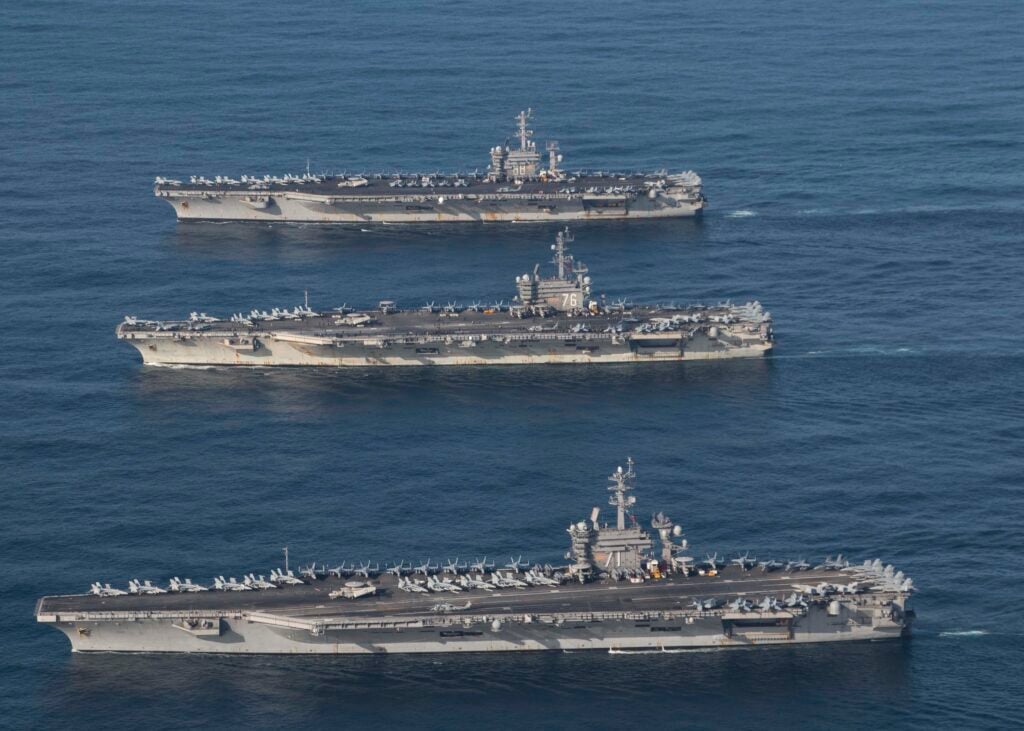Keep 12 Carriers, It’s A National Imperative: Rep. Wittman
Posted on

Three aircraft carriers exercise together in the Pacific, the first exercise that big since 2007. Near to far: USS Theodore Roosevelt (CVN-71), USS Ronald Reagan (CVN-76), USS Nimitz (CVN-68)
The biggest story of the 2020 budget is likely to be the one we first reported: Amidst rising anxiety over whether the US Navy’s thousand-foot-long flagships could evade Chinese missiles in a future war, the Pentagon decided to cut the aircraft carrier fleet from 11 today to 10. The military would save tens of billions on overhaul and operations costs that it could invest in other priorities by retiring the Nimitz-class supercarrier USS Truman at least two decades early, rather than refueling its nuclear reactor core in 2024 as planned.
We knew this would spark congressional outrage. Carriers are beloved by many admirals, feared by the Chinese and Russians and strongly supported by many lawmakers, including those who have carriers based in or near their districts or states. What does one of the most influential defense lawmakers on the Hill, Rob Wittman, think about the Trump Administration plan to cut the Truman’s planned life at sea short? Read on! The Editor.
The era of Great Power Competition has begun. We are no longer in the stage of cautiously observing the rise of global rivals—our rivals have arrived. And with our near-pear competitors – Russia and China – investing in their navies, we must now be focused on our mission more than ever. To do this, Chief Naval Operations, Admiral John Richardson outlined the Navy’s plan to ensure the United States can effectively project power and protect our interests around the world. Unsurprisingly, that plan called for a Navy with 12 aircraft carriers.
At the heart of the Navy’s mission is leveraging the unique capability of an aircraft carrier. As a standalone platform, a carrier is a mobile airfield that can deliver sorties of tactical aircraft hundreds of miles from anywhere in the world. When you add the ships, sensors, firepower and personnel that make up a carrier strike group, you amass a network of systems that can project out thousands of miles. Defense in depth and maneuverability are unique to a carrier strike group, making it the only airfield likely to survive in a conflict against China and Russia.
This unmatched capability is the strategic advantage the United States has over our adversaries—the competitive advantage that allows us to control the sea. Our carriers act as a powerful deterrent to rival nation states. It is no coincidence that the Chinese have begun construction of a third aircraft carrier with intentions of fielding anywhere between four and six in the future. This is a clear attempt to mitigate our ability to hold China at risk.

Rep. Rob Wittman
Some would suggest that our advances in command and control, autonomous systems, and improvements to smaller surface combatants deploying as a Surface Action Group are a more cost-effective option to keep our adversaries at risk. While I agree that the need to continue to invest in these areas is important, it is impossible to ignore the unique capability that a moving airfield can provide.
The Navy’s 30-year Shipbuilding Plan outlines a requirement of 12 carriers beyond 2060, building one carrier every four years with the next scheduled for delivery in 2023. This will ensure that we maintain the ability to deploy two, or even three, aircraft carriers for routine patrols and to increase surge capabilities should the need arise. This number also allows for the continuous maintenance and upkeep of our carriers and the assigned cruisers and destroyers. As such, I believe it is imperative for our nation to provide consistent and stable funding for both the acquisition of new Ford-class and the maintenance and upkeep of current Nimitz-class carriers.
In an ill-conceived attempt to save money in the short term by the Obama Administration, in 2014, the President’s budget excluded funding for the mid-life overhaul of the USS George Washington (CVN-73). This overhaul doubles the service-life of our aircraft carrier. This exclusion, had Congress not reversed it, would have caused a reshuffling of the maintenance and deployment plans for all other carriers and support ships; resulting in an overall decreased carrier presence and uncertainty in the shipbuilding industrial base. Ultimately, resulting in a Navy that is less-ready.
Recent reports have surfaced that the Trump Administration is considering a similar tactic. Instead of striving towards the 12 carriers the Navy says it needs to meet our operational goals, a plan to cancel the mid-life overhaul and retire an aircraft carrier would cause the carrier fleet to shrink in size from 11 to ten. Let me be clear, we cannot allow this critical piece of the United States Naval Force to atrophy. Since the dawn of naval aviation, the ability of the United States to project airpower from the sea from anywhere in the world has ensured access to the maritime domain and is the cornerstone of U.S. naval power. Any attempt to delay the procurement ofFord-class carriers or maintenance timelines for Nimitz-class carriers is strategically and fiscally irresponsible and will undoubtedly be met with the same resistance as it did in 2014.
Rep. Rob Wittman, is the top Republican on the House Armed Services seapower and projection forces subcommittee. He also serves on the HASC tactical air and land subcommittee.
Subscribe to our newsletter
Promotions, new products and sales. Directly to your inbox.
